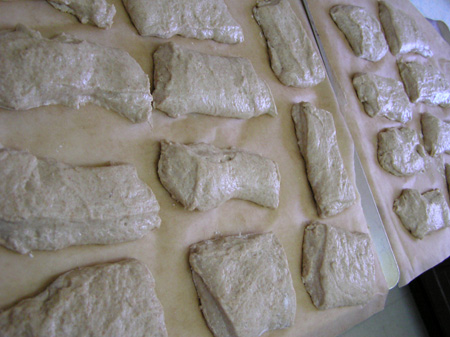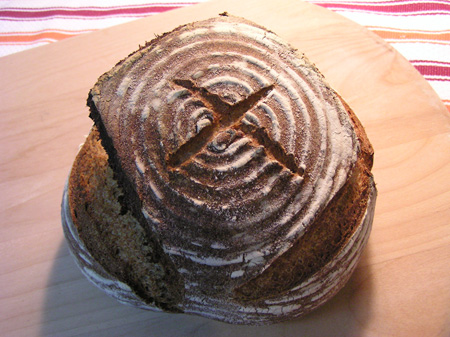
As we travel through life, we tend to collect things. Sometimes we collect things consciously, sometimes we don’t.
I love books. I love to read (although I have to admit that I don’t always read with the same gusto as I used to), and I love the feel and look of books. Cookbooks are especially alluring for me. A good cookbook tells a story. A good cookbook can transport you to another place or time. I have 128 cookbooks. I just counted. How many do I use? If I had to give you an honest number without going back and looking, I would guess a dozen. It’s not that I don’t love most of these books; it’s just that cooking, like fashion changes with the times and it changes as a person’s tastes may change.
In the eighties, I went through a healthy phase and fancied myself to be a vegetarian. I was devoted to Molly Katzen’s Moosewood cookbooks and I yearned to be devoted to others. I purchased the Laurel’s Kitchen Cookbook but couldn’t really fall in love with the book. Therefore, it was the first of many books to gather dust on my shelves. Around the same time, I started to develop a desire to bake bread which I didn’t fulfill for many years to come. I let myself purchase the Laurel’s Kitchen Bread Book during that same era. The bread book promised that you could bake whole grain bread without the use of refined flours. The book was very scary to me.
I am now a much more confident bread baker so this week, I bravely dusted off the Laurel’s Kitchen Bread Book. Although this book is such a product of its time, it also seems very relevant to me. Trends repeat themselves and with the local food and organic movements in full swing, a book like this is a good teacher. Here is a book that can help you buy the healthy whole grains we are told we need to eat and guide us to be self sufficient and know that the food we create is pure.
I feel silly knowing that I have acquired so many bread books recently as my baking passion has intensified. So many of these books look pretty but don’t necessarily teach a person to bake. I’ve had this informative book all along. A book with few pictures that in reading the text, really teaches baking.
The recipe I zeroed in on was the sour corn rye bread. The original recipe was not called sour because of a starter. The recipe includes yogurt and vinegar. I set about to calculate the necessary changes to make the bread work with my starter.
This bread was an adventure back in time for me. I tend to rely on my kitchen aid standing mixer for creating my dough. This recipe called for an unusual method of kneading. A half cup of water is set aside and as you mix and then knead the dough, you keep dipping your hands in the water to incorporate it slowly into the dough until the dough goes from dry and hard to soft and then “dramatically sticky”. I have no idea how to do this with my mixer. By hand it took twenty minutes or so and I did not feel the need to work out at the gym afterwards.
Rye breads always freak me out a little. For some reason, they never seem to rise for me. When I give you the recipe below, rising and proofing times will be vague and general based on a cool day in my kitchen and the fact that I left to buy groceries for the week during this time. Your results may vary.
The resulting bread was fantastic! It was everything I expect from an excellent loaf of rye bread. The bread became tall in the oven. It baked up perfectly. The texture was dense but had a really good crumb and it smelled and tasted amazing! I wrapped the bread in plastic last night and stored it in my cupboard. I expected the bread to suffer from this treatment. When I opened the bag this morning to serve a slice for breakfast, the most wonderful aroma enveloped me. The bread was still perfect. It did not taste stale at all!!
If you are a sourdough baker, I highly encourage you to try this recipe. (R., that means you!)
I am proud to submit this recipe to this week’s YeastSpotting event on Wild Yeast. Please visit Wild Yeast every Friday to see other amazing adventures in bread!
Sour Corn Rye
Adapted from the Laurel’s Kitchen Bread Book
¾ cup cornmeal
¾ cup boiling water
3 1/3 cups whole wheat flour
2 cups rye flour
2 tbsp caraway seeds
2 ½ tsp salt
1 ½ cups nonfat plain yogurt
2 tbsp cider vinegar
¼ cup olive oil
2 tbsp honey
1/3 cup active sourdough starter
½ cup room temperature water
Stir the cornmeal into the boiling water in medium sized bowl and set the mixture aside.
Mix the whole wheat flour, rye flour, caraway seeds and salt in a large bowl.
Mix the yogurt, vinegar, olive oil and honey into the cornmeal mixture. Stirring the mixture until smooth.
Stir the wet ingredients and the sourdough starter into the dry ingredients. Use your hands to work the mixture together into a dough. The dough will be really stiff at this point. Once the ingredients seem to meld together enough, turn them out onto a very lightly floured board. Have the half cup of water beside you in a bowl flat enough that you can dip your fingers into it easily. Knead the bread 10 times and then dip your hands in the water and continue kneading. You will repeat the process of kneading about 10 times and dipping your hands until you have incorporated all of the water into the dough (crazy I know! But the book recommends we knead whole grain dough 600 strokes!). Use a bench scraper to keep the dough moving if it sticks too much. After the water has been incorporated, the dough will be soft. Keep kneading until the dough becomes dramatically sticky and then stop (I decided mine was ready when it stuck to the board and wouldn’t budge). The book states this should take 15 minutes, it took more like 20 minutes for me.
Oil a large bowl. Form the dough into a ball and place the ball smooth side up in the bowl. Cover the bowl with a clean cloth and allow it to ferment for 1 ½ to 2 hours (I did two hours because my kitchen was cool. You should be able to poke the dough and have the hole fill in; I was impatient and moved on to the next step although my dough was stubborn). Press the dough flat and then form it into a smooth round. Let the dough rise. The book states this should take half the time the first rise did but we are working with starter now (not conventional yeast). I went grocery shopping, came back, the dough still wasn’t ready so I the second rise actually took four hours.
Press the dough flat and divide it in two. Form each half into a smooth ball, pulling but not breaking the surface so that it is taut. Pinch the seam at the bottom until smooth. Dust a peel or a cookie sheet with corn meal. Place the dough on the cornmeal dusted implement and let the dough proof for up to an hour and a half until the dough returns a gently made fingerprint. Slash the surface of each loaf.
During the proofing time, place a pizza stone into the oven and preheat the oven to 400 degrees F. When the dough is ready, place the two pieces of dough on the pizza stone in the oven and bake for 10 minutes. Lower the heat to 350 degrees and continue baking for 50 minutes. Remove the bread, and allow the bread to cool on a rack completely before cutting.




















